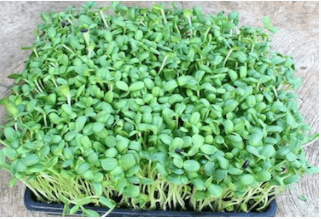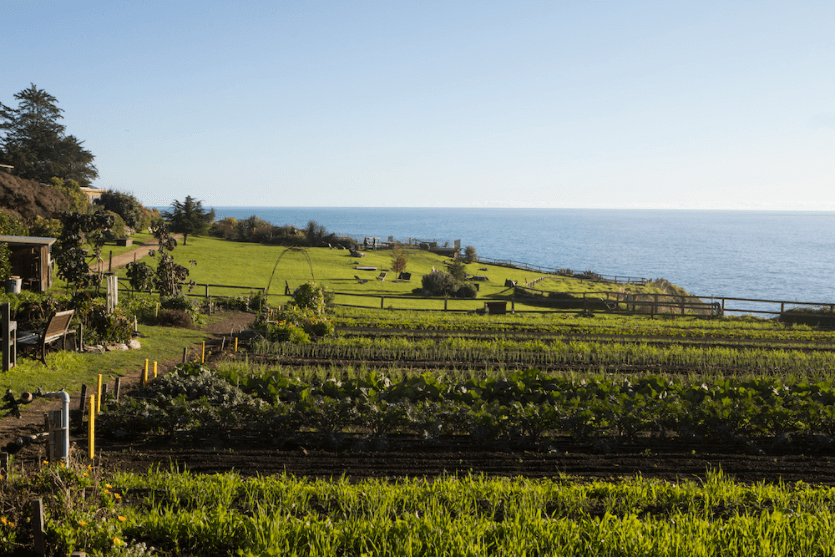
“There is a great deal of talk about gardens right now and the importance of creating our own self-sufficient food source during these uncertain times,” says Esalen Farm Supervisor Chris Omer. “Gardens can be a cathartic place for healing and reflection. They can open up spaces for personal creativity, curiosity about the natural world around us, collaboration with others and play.”
While gardening space is plentiful at Esalen, Chris and the farm staff recently experimented with growing microgreens, which refer to any vegetables, herbs or flowers sown very densely, usually in containers, and harvested just after the initial seed leaves develop.
“They are loaded with nutrients and taste deliciously complex,” Chris adds. “Growing microgreens at home can be a great entry point into growing one’s own food, especially for those without access to a garden. It’s also a great project to add to the homeschool curriculum for children right now.”
Chris goes on to explain how placing our hands in soil promotes a physicality with the body, and that this simple interaction with the multitude of microbial life has been proven to strengthen immune systems and enhance mood—a definite perk during COVID-19 and the stay-at-home measures that sprouted.
Gardening can also serve as a gateway to understanding and creating what Esalen faculty Charles Eisenstein calls, “the more beautiful world our hearts know is possible.”
Chris maps out how Esalen Farm and Garden approaches growing microgreens below. Enjoy.
Common Seeds That Work Well for Microgreens:
“Feel free to use others that you resonate with,” Chris says. “Just stay away from the solanum family—eggplant, peppers, tomatoes and potatoes.”
Supplies Needed:
Steps to Growing Microgreens:


“Remembering to be as self compassionate as I can and praying to the divine that we're all a part of.”
–Aaron
“Prayer, reading, meditation, walking.”
–Karen
“Erratically — which is an ongoing stream of practice to find peace.”
–Charles
“Try on a daily basis to be kind to myself and to realize that making mistakes is a part of the human condition. Learning from our mistakes is a journey. But it starts with compassion and caring. First for oneself.”
–Steve
“Physically: aerobic exercise, volleyball, ice hockey, cycling, sailing. Emotionally: unfortunately I have to work to ‘not care’ about people or situations which may end painfully. Along the lines of ‘attachment is the source of suffering’, so best to avoid it or limit its scope. Sad though because it could also be the source of great joy. Is it worth the risk?“
–Rainer


“It's time for my heart to be nurtured on one level yet contained on another. To go easy on me and to allow my feelings to be validated, not judged harshly. On the other hand, to let the heart rule with equanimity and not lead the mind and body around like a master.”
–Suzanne
“I spend time thinking of everything I am grateful for, and I try to develop my ability to express compassion for myself and others without reservation. I take time to do the things I need to do to keep myself healthy and happy. This includes taking experiential workshops, fostering relationships, and participating within groups which have a similar interest to become a more compassionate and fulfilled being.“
–Peter


“Self-forgiveness for my own judgments. And oh yeah, coming to Esalen.”
–David B.
“Hmm, this is a tough one! I guess I take care of my heart through fostering relationships with people I feel connected to. Spending quality time with them (whether we're on the phone, through messages/letters, on Zoom, or in-person). Being there for them, listening to them, sharing what's going on with me, my struggles and my successes... like we do in the Esalen weekly Friends of Esalen Zoom sessions!”
–Lori

“I remind myself in many ways of the fact that " Love is all there is!" LOVE is the prize and this one precious life is the stage we get to learn our lessons. I get out into nature, hike, camp, river kayak, fly fish, garden, I create, I dance (not enough!), and I remain grateful for each day, each breath, each moment. Being in the moment, awake, and remembering the gift of life and my feeling of gratitude for all of creation.”
–Steven
“My physical heart by limiting stress and eating a heart-healthy diet. My emotional heart by staying in love with the world and by knowing that all disappointment and loss will pass.“
–David Z.
Today, September 29, is World Heart Day. Strike up a conversation with your own heart and as you feel comfortable, encourage others to do the same. As part of our own transformations and self-care, we sometimes ask for others to illuminate and enliven our hearts or speak our love language.
What if we could do this for ourselves too, even if just for today… or to start a heart practice, forever?

“There is a great deal of talk about gardens right now and the importance of creating our own self-sufficient food source during these uncertain times,” says Esalen Farm Supervisor Chris Omer. “Gardens can be a cathartic place for healing and reflection. They can open up spaces for personal creativity, curiosity about the natural world around us, collaboration with others and play.”
While gardening space is plentiful at Esalen, Chris and the farm staff recently experimented with growing microgreens, which refer to any vegetables, herbs or flowers sown very densely, usually in containers, and harvested just after the initial seed leaves develop.
“They are loaded with nutrients and taste deliciously complex,” Chris adds. “Growing microgreens at home can be a great entry point into growing one’s own food, especially for those without access to a garden. It’s also a great project to add to the homeschool curriculum for children right now.”
Chris goes on to explain how placing our hands in soil promotes a physicality with the body, and that this simple interaction with the multitude of microbial life has been proven to strengthen immune systems and enhance mood—a definite perk during COVID-19 and the stay-at-home measures that sprouted.
Gardening can also serve as a gateway to understanding and creating what Esalen faculty Charles Eisenstein calls, “the more beautiful world our hearts know is possible.”
Chris maps out how Esalen Farm and Garden approaches growing microgreens below. Enjoy.
Common Seeds That Work Well for Microgreens:
“Feel free to use others that you resonate with,” Chris says. “Just stay away from the solanum family—eggplant, peppers, tomatoes and potatoes.”
Supplies Needed:
Steps to Growing Microgreens:


“Remembering to be as self compassionate as I can and praying to the divine that we're all a part of.”
–Aaron
“Prayer, reading, meditation, walking.”
–Karen
“Erratically — which is an ongoing stream of practice to find peace.”
–Charles
“Try on a daily basis to be kind to myself and to realize that making mistakes is a part of the human condition. Learning from our mistakes is a journey. But it starts with compassion and caring. First for oneself.”
–Steve
“Physically: aerobic exercise, volleyball, ice hockey, cycling, sailing. Emotionally: unfortunately I have to work to ‘not care’ about people or situations which may end painfully. Along the lines of ‘attachment is the source of suffering’, so best to avoid it or limit its scope. Sad though because it could also be the source of great joy. Is it worth the risk?“
–Rainer


“It's time for my heart to be nurtured on one level yet contained on another. To go easy on me and to allow my feelings to be validated, not judged harshly. On the other hand, to let the heart rule with equanimity and not lead the mind and body around like a master.”
–Suzanne
“I spend time thinking of everything I am grateful for, and I try to develop my ability to express compassion for myself and others without reservation. I take time to do the things I need to do to keep myself healthy and happy. This includes taking experiential workshops, fostering relationships, and participating within groups which have a similar interest to become a more compassionate and fulfilled being.“
–Peter


“Self-forgiveness for my own judgments. And oh yeah, coming to Esalen.”
–David B.
“Hmm, this is a tough one! I guess I take care of my heart through fostering relationships with people I feel connected to. Spending quality time with them (whether we're on the phone, through messages/letters, on Zoom, or in-person). Being there for them, listening to them, sharing what's going on with me, my struggles and my successes... like we do in the Esalen weekly Friends of Esalen Zoom sessions!”
–Lori

“I remind myself in many ways of the fact that " Love is all there is!" LOVE is the prize and this one precious life is the stage we get to learn our lessons. I get out into nature, hike, camp, river kayak, fly fish, garden, I create, I dance (not enough!), and I remain grateful for each day, each breath, each moment. Being in the moment, awake, and remembering the gift of life and my feeling of gratitude for all of creation.”
–Steven
“My physical heart by limiting stress and eating a heart-healthy diet. My emotional heart by staying in love with the world and by knowing that all disappointment and loss will pass.“
–David Z.
Today, September 29, is World Heart Day. Strike up a conversation with your own heart and as you feel comfortable, encourage others to do the same. As part of our own transformations and self-care, we sometimes ask for others to illuminate and enliven our hearts or speak our love language.
What if we could do this for ourselves too, even if just for today… or to start a heart practice, forever?

“There is a great deal of talk about gardens right now and the importance of creating our own self-sufficient food source during these uncertain times,” says Esalen Farm Supervisor Chris Omer. “Gardens can be a cathartic place for healing and reflection. They can open up spaces for personal creativity, curiosity about the natural world around us, collaboration with others and play.”
While gardening space is plentiful at Esalen, Chris and the farm staff recently experimented with growing microgreens, which refer to any vegetables, herbs or flowers sown very densely, usually in containers, and harvested just after the initial seed leaves develop.
“They are loaded with nutrients and taste deliciously complex,” Chris adds. “Growing microgreens at home can be a great entry point into growing one’s own food, especially for those without access to a garden. It’s also a great project to add to the homeschool curriculum for children right now.”
Chris goes on to explain how placing our hands in soil promotes a physicality with the body, and that this simple interaction with the multitude of microbial life has been proven to strengthen immune systems and enhance mood—a definite perk during COVID-19 and the stay-at-home measures that sprouted.
Gardening can also serve as a gateway to understanding and creating what Esalen faculty Charles Eisenstein calls, “the more beautiful world our hearts know is possible.”
Chris maps out how Esalen Farm and Garden approaches growing microgreens below. Enjoy.
Common Seeds That Work Well for Microgreens:
“Feel free to use others that you resonate with,” Chris says. “Just stay away from the solanum family—eggplant, peppers, tomatoes and potatoes.”
Supplies Needed:
Steps to Growing Microgreens:


“Remembering to be as self compassionate as I can and praying to the divine that we're all a part of.”
–Aaron
“Prayer, reading, meditation, walking.”
–Karen
“Erratically — which is an ongoing stream of practice to find peace.”
–Charles
“Try on a daily basis to be kind to myself and to realize that making mistakes is a part of the human condition. Learning from our mistakes is a journey. But it starts with compassion and caring. First for oneself.”
–Steve
“Physically: aerobic exercise, volleyball, ice hockey, cycling, sailing. Emotionally: unfortunately I have to work to ‘not care’ about people or situations which may end painfully. Along the lines of ‘attachment is the source of suffering’, so best to avoid it or limit its scope. Sad though because it could also be the source of great joy. Is it worth the risk?“
–Rainer


“It's time for my heart to be nurtured on one level yet contained on another. To go easy on me and to allow my feelings to be validated, not judged harshly. On the other hand, to let the heart rule with equanimity and not lead the mind and body around like a master.”
–Suzanne
“I spend time thinking of everything I am grateful for, and I try to develop my ability to express compassion for myself and others without reservation. I take time to do the things I need to do to keep myself healthy and happy. This includes taking experiential workshops, fostering relationships, and participating within groups which have a similar interest to become a more compassionate and fulfilled being.“
–Peter


“Self-forgiveness for my own judgments. And oh yeah, coming to Esalen.”
–David B.
“Hmm, this is a tough one! I guess I take care of my heart through fostering relationships with people I feel connected to. Spending quality time with them (whether we're on the phone, through messages/letters, on Zoom, or in-person). Being there for them, listening to them, sharing what's going on with me, my struggles and my successes... like we do in the Esalen weekly Friends of Esalen Zoom sessions!”
–Lori

“I remind myself in many ways of the fact that " Love is all there is!" LOVE is the prize and this one precious life is the stage we get to learn our lessons. I get out into nature, hike, camp, river kayak, fly fish, garden, I create, I dance (not enough!), and I remain grateful for each day, each breath, each moment. Being in the moment, awake, and remembering the gift of life and my feeling of gratitude for all of creation.”
–Steven
“My physical heart by limiting stress and eating a heart-healthy diet. My emotional heart by staying in love with the world and by knowing that all disappointment and loss will pass.“
–David Z.
Today, September 29, is World Heart Day. Strike up a conversation with your own heart and as you feel comfortable, encourage others to do the same. As part of our own transformations and self-care, we sometimes ask for others to illuminate and enliven our hearts or speak our love language.
What if we could do this for ourselves too, even if just for today… or to start a heart practice, forever?